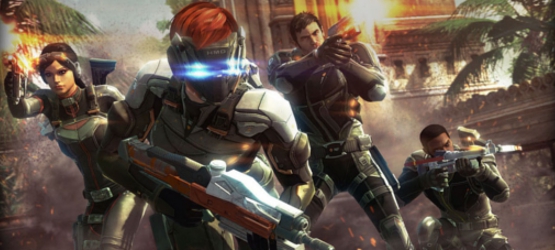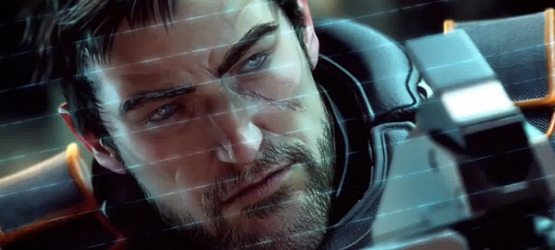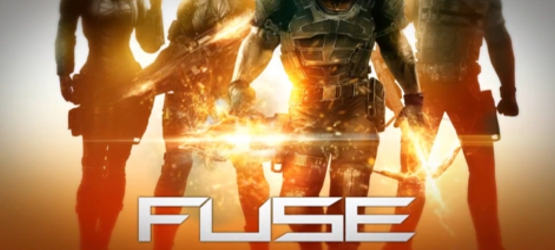Insomniac Games’ first departure from console exclusivity, Fuse, is an example of a game that cannot be taken simply at face value, as it seems to find a way to be uniquely charming, while still looking like it could be lost in the crowd. Being developed by the minds behind the highly weapon focused PS3 exclusives Resistance and Ratchet & Clank, Fuse follows suit by embedding a bit of weaponized science fiction to spice up the third-person shooter genre.
With almost every game having a multiplayer aspect tacked onto it, Fuse seems to embrace the concept of cooperative play instead of crutching on the saturated competitive market. Although it may seem like its options are few and far between, the decision to limit the number of options allows the story campaign and its Echelon (standard wave based co-op) mode to be more focused and less competitive with any tacked on features. This allows up to 4 players to seamlessly drop in and out of a friend’s game, whether it is split-screen or online, as well as push the social aspect of Fuse, without having to split the demographics or sacrifice character abilities to allow for head-to-head.
Being a team based game, there will be times when you will not be able to have a full roster of friends helping you out, so the ability of the AI is going to be a defining factor at least part of the time. Fuse’s computer characters seem to follow a set path of being your back up without having a presence to hinder your own experience. If you are by yourself, they will follow you in line, staying in the back and only putting themselves out there when you are downed. When you only have one friend, you will each have one person shadowing and three people will push the AI to the back, staying almost unseen until they are needed.

Fuse bases its story off of a team called the Overstrike 9, comprised of 4 protagonists armed with unique weapons modified with an alien substance called Fuse. Each weapon held by a different team member has a unique attribute that works almost flawlessly for combat or to assist teammates, allowing each member to be both aggressive and supportive. Using each weapon in conjunction with a teammate’s, creates a strangely addictive chain of events that can clear whole waves of opponents in a matter of seconds, which is by far the biggest highlight of the game.
Much like many third-person shooters, the story is arguably not nearly as important as the mechanics driving them, which is lucky for Fuse, as it has some of the most solid controls I have seen in a while. This generation has provided us with a number of games that have utilized cover mechanics, but almost all of them end up driving the combat to a halt and slowing the pacing down overall. Fuse, on the other hand, uses a nice blend of cover in combination with the ability to hurdle, allowing players to treat any area like a jungle gym and achieve some very memorable gaming moments.
One instance, for example, had me taking cover, stealth killing a inattentive soldier around a corner, shooting a bolt into another soldier’s head, hurdling over to another container, dragging someone over it, then detonating my initial bolt, liquefying a group who had just passed by their dead comrade.

Throughout the game, you will earn XP as well as cash to level up and purchase unlockables that can be used to help you or your friends play either campaign or Echelon. Sadly, as you switch between characters you will soon realize that the skill-tree for each is almost an exact copy of each others. Playing through, you will earn experience for your whole team, which can offset a bit of the grind, but does not make the lack of diversity much easier to digest.
This problem of feeling generic or having seen this before is an issue that is noticeable at the core of Fuse, and will obviously become the most noticeable hurdle for any anyone to actually enjoy the title. From a simple glance, it is easy to see that each of the protagonists look like any forgettable background character you have glanced over a million times. Dialog between the team can be a highlight to bring personality to the team at times, but ultimately fails to really drive home any real attachment to any single character, as those moments are too few and too far apart. This is also not to mention the story, which is something that feels like little more than a tool to drive the Fuse concept.
Visually, Fuse will not win any awards, but the character models are highly detailed and the environments will always try to give you something different. Some levels will have repeating enemies, especially mini-bosses, but with the ability to change characters and the unexpected evolution of the game does give it a much needed sense of diversity.
Fuse is by almost every aspect, a solid title. Anyone who decides to pick it up should not have any major complaints, as long as they understand what they are picking up in the first place. Fuse is a standard cooperative third person shooter developed by a top tier developer, but it is not a life altering experience or a game that will stand the test of time for years to come.
*This copy was provided by the Publisher
-
Excellent controls
-
Fun combat
-
Seamless drop in/out
-
Great co-op
-
Badass weapons
-
Strangely addicting
-
Looks generic
-
Level grind
-
Weak story








